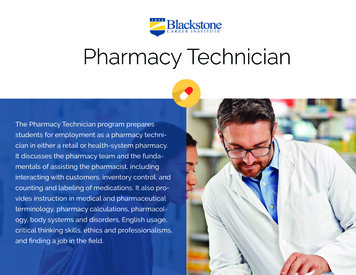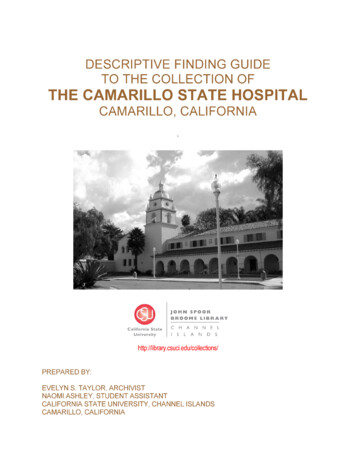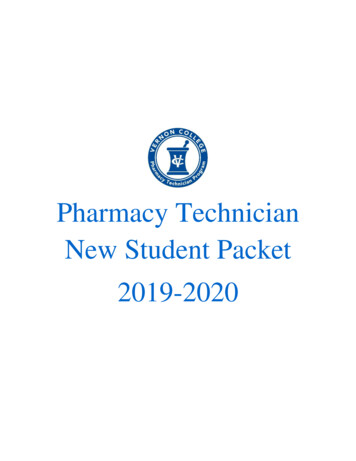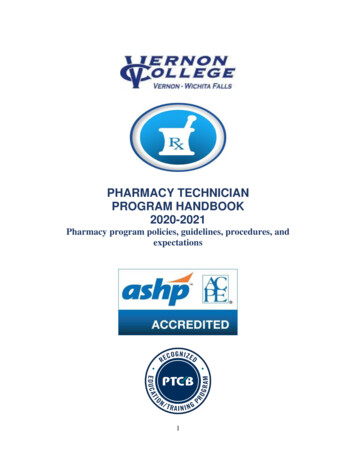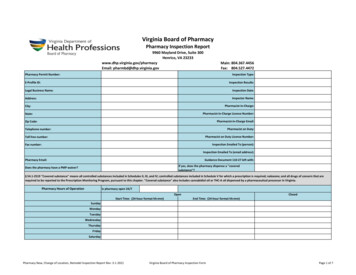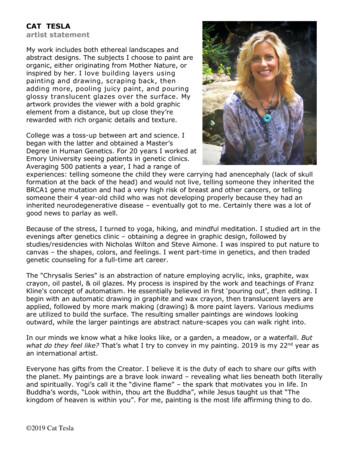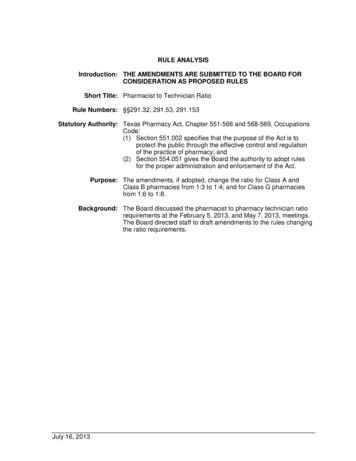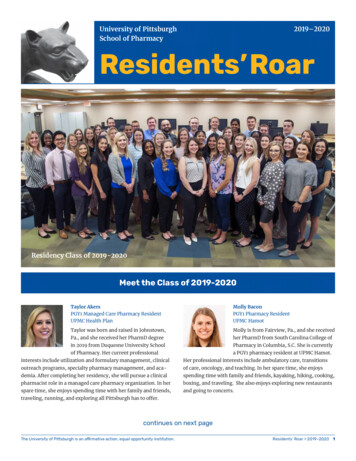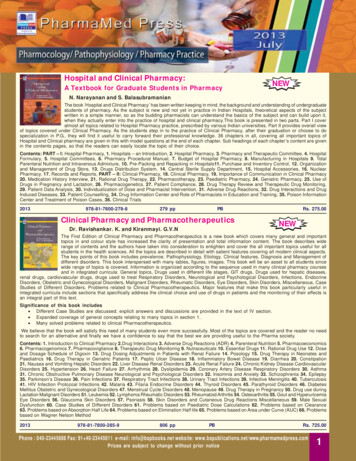
Transcription
Pharmacology / Pathophysiology / Pharmacy PracticePharmaMed PressHospital and Clinical Pharmacy:A Textbook for Graduate Students in PharmacyNEWN. Narayanan and S. BalasubramanianThe book ‘Hospital and Clinical Pharmacy’ has been written keeping in mind, the background and understanding of undergraduatestudents of pharmacy. As the subject is new and not yet in practice in Indian Hospitals, theoretical aspects of the subjectwritten in a simple manner, so as the budding pharmacists can understand the basics of the subject and can build upon it,when they actually enter into the practice of hospital and clinical pharmacy.This book is presented in two parts. Part I coveralmost all topics related to Hospital Pharmacy practice, prescribed by various Indian universities. Part II provides overall viewof topics covered under Clinical Pharmacy. As the students step in to the practice of Clinical Pharmacy, after their graduation or choose to dospecialization in P.G., they will find it useful to carry forward their professional knowledge. 36 chapters in all, covering all important topics ofHospital and Clinical pharmacy are given in this with model questions at the end of each chapter. Sub headings of each chapter’s content are givenin the contents pages, so that the readers can easily locate the topic of their choice.Contents: PART – I: Hospital Pharmacy, 1. Hospitals – an Introduction, 2. Hospital Pharmacy, 3. Pharmacy and Therapeutic Committee, 4. HospitalFormulary, 5. Hospital Committees, 6. Pharmacy Procedural Manual, 7. Budget of Hospital Pharmacy, 8. Manufacturing in Hospitals 9. TotalParenteral Nutrition and Intravenous Admixture, 10. Pre-Packing and Repacking in Hospitals11. Purchase and Inventory Control, 12. Organizationand Management of Drug Store, 13. Drugs Distribution System, 14. Central Sterile Supply Department, 15. Hospital Accessories, 16. NuclearPharmacy, 17. Records and Reports, PART – II: Clinical Pharmacy, 18. Clinical Pharmacy, 19. Importance of Communication in Clinical Pharmacy20. Medication History Interview, 21. Rational Drug Therapy, 22. Pharmacotherapy, 23. Paediatric Pharmacy, 24. Geriatric Pharmacy, 25. Use ofDrugs in Pregnancy and Lactation, 26. Pharmacogenetics, 27. Patient Compliance, 28. Drug Therapy Review and Therapeutic Drug Monitoring,29. Patient Data Analysis, 30. Individualization of Dose and Pharmacist Intervention, 31. Adverse Drug Reactions, 32. Drug Interactions and DrugInduced Diseases, 33. Patient Counselling, 34. Drug Information Center and Role of Pharmacists in Education and Training, 35. Poison InformationCenter and Treatment of Poison Cases, 36. Clinical Trials2013978-81-7800-279-8279 ppPBClinical Pharmacy and PharmacotherapeuticsDr. Ravishankar. K. and Kiranmayi. G.V.NRs. 275.00NEWThe First Edition of Clinical Pharmacy and Pharmacotherapeutics is a new book which covers many general and importanttopics in and colour style has increased the clarity of presentation and total information content. The book describes widerange of contents and the authors have taken into consideration to enlighten and cover the all important topics useful for allstudents in the health sciences. All the topics are described in detail with salient features covering all modern clinical aspects.The key points of this book includes prevalence, Pathophysiology, Etiology, Clinical features, Diagnosis and Management ofdifferent disorders. This book interspersed with many tables, figures, images. This book will be an asset to all students sincewide range of topics is covered. Information is organized according to the sequence used in many clinical pharmacy coursesand in integrated curricula: General topics, Drugs used in different life stages, GIT drugs, Drugs used for hepatic diseases,renal drugs, cardiovascular drugs, drugs used to treat Respiratory Disorders, Neurological and Psychological Disorders, Infections, EndocrineDisorders, Obstetric and Gynecological Disorders, Malignant Disorders, Rheumatic Disorders, Eye Disorders, Skin Disorders, Miscellaneous, CaseStudies of Different Disorders, Problems related to Clinical Pharmacotherapeutics. Major features that make this book particularly useful inintegrated curricula include sections that specifically address the clinical choice and use of drugs in patients and the monitoring of their effects isan integral part of this text.Significance of this book includes Different Case Studies are discussed; explicit answers and discussions are provided in the text of IV section. Expanded coverage of general concepts relating to many topics in section 1. Many solved problems related to clinical Pharmacotherapeutics.We believe that the book will satisfy this need of many students even more successfully. Most of the topics are covered and the reader no needto search for an alternative and finally we have a confidence to say that the best we are providing useful to the Pharma society.Contents: 1. Introduction to Clinical Pharmacy 2.Drug Interactions 3. Adverse Drug Reactions (ADR) 4. Parenteral Nutrition 5. Pharmacoeconomics6. Pharmacogenomics 7. Pharmacovigilance 8. Therapeutic Drug Monitoring 9. Nutraceuticals 10. Essential Drugs 11. Rational Drug Use 12. Doseand Dosage Schedule of Digoxin 13. Drug Dosing Adjustments in Patients with Renal Failure 14. Posology 15. Drug Therapy in Neonates andPaediatrics 16. Drug Therapy in Geriatric Patients 17. Peptic Ulcer Disease 18. Inflammatory Bowel Disease 19. Diarrhea 20. Constipation21. Nausea and Vomiting Hepatic Disorders 22. Liver Disease Renal Disorders 23. Acute Renal Failure 24. Chronic Kidney Disease CardiovascularDisorders 25. Hypertension 26. Heart Failure 27. Arrhythmia 28. Dyslipidemia 29. Coronary Artery Disease Respiratory Disorders 30. Asthma31. Chronic Obstructive Pulmonary Disease Neurological and Psychological Disorders 32. Insomnia and Anxiety 33. Schizophrenia 34. Epilepsy35. Parkinson’s Disease 36. Pain Infections 37. Respiratory Tract Infections 38. Urinary Tract Infections 39. Infective Meningitis 40. Tuberculosis41. HIV Infection Protozoal Infections 42. Malaria 43. Filaria Endocrine Disorders 44. Thyroid Disorders 45. Parathyroid Disorders 46. DiabetesMellitus Obstetric and Gynecological Disorders 47. Menstrual Cycle Disorders 48. Menopause 49. Drug Therapy in Pregnancy 50. Drug use duringLactation Malignant Disorders 51. Leukemia 52. Lymphoma Rheumatic Disorders 53. Rheumatoid Arthritis 54. Osteoarthritis 55. Gout and HyperuricemiaEye Disorders 56. Glaucoma Skin Disorders 57. Psoriasis 58. Skin Disorders and Cutaneous Drug Reactions Miscellaneous 59. Male SexualDysfunction 60. Case Studies of Different Disorders 61. Problems based on Paediatric Dose Calculations 62. Problems based on Clearance63. Problems based on Absorption Half Life 64. Problems based on Elimination Half life 65. Problems based on Area under Curve (AUC) 66. Problemsbased on Wagner Nelson Method2013978-81-7800-285-9806 ppPBRs. 725.00Phone : 040-23445688 Fax: 91 40-23445611 e-mail: info@bspbooks.net website: s are subject to change without prior notice1
Pharmacology / Pathophysiology / Pharmacy PracticePharmaMed PressRodents for Pharmacological ExperimentsNEWDr. Tapan Kumar ChatterjeeContents: SECTION - A: GENERAL DISCUSSION ABOUT MICE AND RATS The Laboratory Mouse Data Related to Mice(Tables) The Laboratory Rat Data Related to Rats (Tables) SECTION - B EXPERIMENTS ON MICE AND RATS Instruments used for Mice and Rats Experiments Drug Doses used on Laboratory Mice and RatsAbout the AuthorDr.T.K. Chatterjee, an Ex-UGC( Govt. of India) Research Scientist and presently a Faculty member of the Department ofPharmaceutical Technology, Jadavpur University, Kolkata, has been actively engaged in Pharmacological & toxicologicalresearch and teaching for the last 3 decades.He has been resourceful contributor of more than ninety research papers in journals of National and International reputeand he has to his trust worthiness as a distinguished author of books entitled “Hand book on Laboratory Mice & Rats” (1993), “HerbalOptions” (1st edition 1996, 2 nd edition 1997, 3rd edition 1999), “Chemotherapy of Tropical Parasitic Infections” (1st edition 1995, 2 nd edition1999), “Skin – Diseases and Treatment” (1st edition 1999) , “A Handbook of Pharmacology” (2011),”Antidiabetic plant Stereospermumsuaveolens (Roxb.) DC” (2012), “Pharmacological properties of Coccinia grandis L.Voigt” (2012), “Medicinal plant Abrusprecatorious L.” (2012) that attracted widespread recognition from various organization of Pharmaceutical, Medical and allied sciences.International conferences in different countries like Sweden, Germany, Belgium and U.K. have also been enriched by his resourceful papers, anumber of times. Dr. Chatterjee is also a freelance Bio-Medical writer with appreciable expertise. He was felicitated by different organizationsawarding him with prestigious awards like Ram Mohan Puraskar, Aadi Samman, NIMA Award, NAGARJUN PURASKAR etc. for hiscontribution in Pharmaceutical sciences. With the discovery of a new antibiotic MT81 (Patent No. 156916), Dr. Chatterjee’s research work standsin high esteem embracing in depth study on the subject, and thus adding a new plume into his ever increasing contribution in the fields of Medicalhealthcare.2013978-81-7800-283-5288 ppHBTextbook of ToxicologyRs. 1295.00Coming SoonP K GuptaContents: 1. Introduction and Historical Background 2. Definitions and Scope of Toxicology 3. Classification of Poisons /Toxicants 4. Factors Affecting Toxicity 5. Natural Laws Concerning Toxicology 6. Hazard and Risk Assessment 7. Absorption,Distribution and Excretion of Toxicants 8. Biotransformation 9. Principles and Basic Concepts of Toxicokinetics Unit 3Regulatory Requirements and GLP 10. Toxicological Testing: Genesis 11. Toxicological Testing: in vivo Systems12. Toxicological testing: in vitro models 13. Genotoxicity 14. Preclinical Toxicological Investigations of PharmaceuticalProducts 15. Preclinical safety evaluation of biotechnology-derived products 16. Pre-clinical Regulatory Toxicology forBiomaterials and Medical Devices Unit 4 Toxic Agents 17. Toxic Effects of Pesticides (Agrochemicals) 18. Toxic Effectsof Metals 19. Toxic Effects of Non-Metalics 20. Neurotoxic Agents 21. Toxic Effects of Cardiac Poisons 22. Toxic Effects ofAsphyxiants 23. Toxic Effects of Caustics (Corrosives) 24. DRUG TOXICITY, DEPENDENCE AND ABUSE 25. Toxic Effects of Domestic Chemicals26. TOXIC Effects of Poisonous Plants 27. Food Poisoning and Poisonous Foods 28. Poisons of Animal Origin 29. Chemical FOOD Poisoning 30.Health Effects of Radioactive materials Unit 5 Applications of Toxicology 31. Basic Concepts of Forensic Toxicology 32. Analytical Toxicology33. Clinical Toxicology 34. Treatment of Poisoning2013308 ppPBTBAModern Toxicology:An Authoritative and Comprehensive Resource for Toxicology, 3 Vol. setP. K. GuptaModern Toxicology, 3 volume set, is the first complete reference written specifically for students having interest intoxicology bringing together all aspects of modern toxicology. It provides an advanced text covering the basic and clinicalprincipals of organ and reproduction toxicology, adverse effects of xenobiotics, and immuno-toxicology and clinicalaspects of a wide range of poisons and poisonings in animals and humans beings. Thus these volumes are intended togive a better understanding for use in formal courses in the graduate programs in toxicology or self-study by thoseindividuals who wish to be accredited by various organizations concerned with toxicology who are required to have amulti-disciplinary knowledge in areas like environmental health, clinical and forensic toxicology (detection of intentional orunintentional toxic substances) or in industry (assessment of hazards of new compounds), government agencies, inprivate commercial laboratories; in material science toxicology (biomedical and engineering disciplines), as educators(courses in pharmacy, medicine, dentistry, agricultural, and veterinary practice); and finally for collection, storing, andretrieving toxicology information. In brief this set represents the collective wisdom of several internationally known toxicologists, and offers aunique text/reference source for those involved in various specialized sections of toxicology. Contributing authors for chapters of the 3 volumeset are the most qualified and well- experienced authorities in their respective areas of toxicology.Salient Features Chapters are fully illustrated and extensively referenced Language is simple to follow and format is designed to easily understand Represents the collective expertise of several internationally known toxicologists Offers a unique text/reference source for those involved in various specialized sections of toxicology Useful to those who involved in biomedical areas and Agriculture, Food Technology, Pharmacy, Veterinary Medicine and related disciplines Also Biologists, Pathologists, Ecologists and Environmentalists will find this volume as useful reference bookContents: VOLUME I Basis of Organ and Reproduction Toxicity: 1. Introduction and Brief History 2. Natural Laws Concerning Toxicology3. Absorption, Distribution and Excretion of Xenobiotics 4. Biotransformation of Xenobiotics 5. Kinetic - analysis of Xenobiotics 6. Behavioral andNeurotoxicity 7. Pulmonary Toxicology 8. Hepatic - Toxicity 9. Reproduction Toxicity and Teratogenicity 10. Carcinogenicity and MutagenicityVOLUME II The adverse Effects of Xenobiotics: 1. Pesticides 2. Metals 3. Food Additives: Abenefit/ Risk Dilemma 4. Animal and Plant Toxins5. Mycotoxins 6. Combustion Toxicology 7. Toxicology of Synthetic Biomaterials 8. Environmental Toxicology VOLUME III Immuno and ClinicalToxicology: 1. Immune System 2. Hypersensitivity and Occupational Allergy 3. Immuno Suppression 4. Principles of Non-specific therapy5. Mechanism of Antidotal Therapy 6. Common Poisons20102978-81-910192-0-9HB3 Vol. SetRs. 3495.00Phone : 040-23445688 Fax: 91 40-23445611 e-mail: info@bspbooks.net website: s are subject to change without prior notice
Pharmacology / Pathophysiology / Pharmacy PracticePharmaMed PressDrug-Drug Interactions:Scientific and Regulatory PerspectivesAlbert P. LiContents: 1. Overview: Pharmacokinetic Drug-Drug Interactions 2. Role of Cytochrome P450 Enzymes in Drug-Drug Interactions3. The liver as Target for Chemical-Chemical Interactions 4. Application of Human Liver Microsomes in Metabolism BasedDrug-Drug Interactions: In Vitro - in Vivo Correlations and The Abbott Laboratories Experience 5. Primary Hepatocyte Culturesas an in Vitro Experimental Model for the Evaluation of Pharmacokinetic Drug-Drug Interactions 6. Liver Slices as a Model inDrug Metabolism 7. Use of cDNA- Expressed Human Cytochrome P450 Enzymes to Study Potential Drug-Drug Interactions8. Pharmacokinetics in Drug Interactions 9. Experimental Models for Enzyme Induction Potential of New Drug Candidates inAnimals and Humans and Strategy for Their Use 10. Metabolic Drug-Drug Interactions: Perspective from FDA Medical and Clinical PharmacologyReviewers 11. Drug Interactions: Perspective of the Canadian Drugs Directorate 12. Overview of Experimental Approaches for Study of DrugMetabolism and Drug-Drug InteractionsRpt. 20119789380931043304 pagesPBRs. 695.00Clinical Pharmacy and Therapeutics, 4th Ed.Eric T. Herfindal, Dick R. Gourley and Linda Lloyd hartContents: Section 1: Nutrition, Section 2: Diseases of Blood, Section 3: Endocrine and metabolic diseases,Section 4: Renal Diseases, Section 5: Gastrointestinal Diseases, Section 6: Rheumatic Diseases, Section 7: RespiratoryDiseases, Section 8: Cardiovascular Disorders, Section 9: Skin Diseases, Section 10: Diseases of the eye,Section 11: Neurologic Disorders, Section 12: Psychiatric Disorders, Section 13: Infectious Diseases, Section 14: NeoplasticDiseases, Section 15: GeneralRpt. 2011978-81-84735-61-1A Practical Guide to Human1096 ppPBRs. 2595.00Research and Clinical TrialsBest SellerEdited by: M. U. R. Naidu and P. Usha RaniContents: 1. Clinical Research – A Clinical Investigator’s Perspective 2. Drug and Device Development Process 3. PreclinicalDrug Development 4. Phases of Clinical Trials 5. Phase 0 - Microdosing Studies 6. Clinical Research Planning 7. ClinicalResearch Design 8. Clinical Research Protocol 9. Designing Case Report Forms 10. Process of Randomization in ClinicalTrials 11. Investigational Medicinal Products 12. Multicenter Clinical Trials 13. Good Clinical Research Practice 14. Role andResponsibilities of Sponsor 15. Role and Responsibilities of Principal Investigator 16. Ethical Consideration in Clinical Research– Special Reference to Developing Countries 17. Informed Consent in Clinical Research 18. Monitoring in Clinical Trials19. Quality Assurance in Clinical Research 20. Pharmacovigilance and Drug Safety 21. Data and Safety Monitoring Board andMonitoring Plan 22. Standard Operating Procedures 23. Archiving Clinical Research Documents 24. Evidence Based Medicine25. Clinical Research Data Management 26. Clinical Biostatistics2011978-81-7800-260-6327 pagesHBRs. 1295.00A Pharmacology Primer:Theory, Applications, and Methods,3rd Ed.Kenakin Terry P.Contents: 1. What is Pharmacology 2. How Different Tissues Process Drug Response 3. Drug-Receptor Theory4. Pharmacological Assay Formats: Binding 5. Agonists: The Measurement of Affinity and Efficacy in Functional Assays6. Orthosteric Drug Antagonism 7. Allosteric Drug Antagonism 8. The Process of Drug Discovery 9. Pharmacokinetics10. Target- and System-Based Strategies for Drug Discovery 11. “Hit” to Drug: Lead Optimization 12. Statistics and ExperimentalDesign 13. Selected Pharmacological Methods 14. Exercise in Pharmacodynamics and PharmacokineticsRpt. 2011978-89-38093-152-4389 pagesPBRs. 1295.00Fundamentals of Drug Metabolism and Drug DispositionBert N. La Du, H. George Mandel, E. Leong WayContents : 1. Transmembrane Movement of Drug Molecules 2. Drug Absorption 3. The distribution of Drugs 4. Protein Binding5. Drug Entry into Brain and Cerebrospinal Fluid 6. Placental Transfer of Drugs 7. Pulmonary Disposition of Drugs 8. RenalExcretion of Drugs 9. Extrarenal Excretion of Drugs 10. Pathways of Drug Biotransformation: Biochemical Conjugations11. Species variations in drug Biotransformations 12. Microsomal Enzyme Systems Which Catalyze 13. EnvironmentalFactors Influencing Drug Metabolism 14. Mechanisms of Induction of Drug Metabolism Enzymes 15. Genetic FactorsModifying Drug Metabolism and Drug Response 16. The Value Determining The Plasma Concentration of Drugs In Animals andMan 17. Application of Metabolic and Disposition Studies In The Development and Evaluation of Drugs 18. Techniques forStudying Drug Disposition In Vivo 19. Techniques for Studying Drug Metabolism In Vitro 20. Isolation Procedures – LiquidExtraction and Isolation Techniques 21. Isolation and Identification Procedures – Spectral Methods 22. Qualitative and QuantitativeApplications of Thin – Layer, Gas – Liquid, and Column Chromatography 23. Applications of Tracer Techniques In Drug Metabolism Studies24. Autoradiography In Drug Disposition Studies 25. Application of Computers In Drug Metabolism Studies 26. General Principles and Procedures forDrug Metabolism In Vitro 27. Experiments Illustration Drug Metabolism In Vitro 28. Experiments Illustrating Drug Distribution and Excretion29. Correlation of Drug Disposition With Pharmacologic ActionsRpt. 2010978-81-88449-89-X615 pagesPBRs. 350.00Phone : 040-23445688 Fax: 91 40-23445611 e-mail: info@bspbooks.net website: s are subject to change without prior notice3
Pharmacology / Pathophysiology / Pharmacy PracticePharmaMed PressFundamentals of Clinical TrialsBest SellerFriedman, Lawrence, Furberg, Curt D., DeMets, David L.Contents: 1. Introduction to Clinical Trials 2. What Is The Question? 3. Study Population 4. Basic Study Design 5. TheRandomization Process 6. Blindness 7. Sample Size 8. Baseline Assessment 9. Recruitment of Study Participants 10. DataCollection and Quality Control 11. Assessing and Reporting Adverse Effects 12. Assessment of Health-Related Quality of Life13. Participant Adherence 14. Survival Analysis 15. Monitoring Response Variables 16. Issues in Data Analysis 17. Closeout18. Reporting and Interpreting of Results 19. Multicenter TrialsRpt. 2009978-81-848-92710361 pagesFundamentals of Clinical Pharmacy PracticePBRs. 995.00Best SellerD. Sudheer Kumar, Dr. J. Krishnaveni and Dr. P. ManjulaContents: 1. Introduction to Clinical Pharmacy 2. Ambulatory Pharmacy 3. Patient Counseling 4. Medication History Review5. Ward Round Participation 6. Monitoring Drug Therapy 7. Therapeutic Drug Monitoring 8. Drug Utilization Review 9. DrugInformation Services 10. Drug-Drug Interactions 11. Drug – Food / Herb Interactions 12. Drug – Lab Interactions 13. MedicationErrors 14. Adverse Drug Reactions and Management 15. Total Parenteral Nutrition 16. Drugs in Pregnancy and Lactation17. Technology and Automation 18. Pharmacoeconomics 19. Pharmacoepidemiology 20. Clinical Laboratory Tests and TheirSignificance Appendix 1-192010978-81-910192-7-8517 pagesPBRs. 350.00Biological Standardization, 2nd Ed.J.H. Burn, D.J Finney and L.G. GoodwinContents: 1. Units of measurement 2. The classification of methods 3. Statistical analysis 4. Pituitary (Posterior lobe) extract5. Insulin 6. The hormones of the suprarenal gland 7. Thyroid 8. Parathyroid extract 9. The ovarian hormones 10. Malehormones 11. Anterior lobe of the pituitary gland 12. Vitamin D 13. Digitals, strophanthus and squill 14. Antipyretic andanalgesics 15. Atropine substitutes 16. Local Anaesthetics 17. Gastric secretion 18. Secretin and Pancreozymin 19. Quinidinesubstitutes 20. Curare-like compounds 21. Anthelminthic substances 22. Trypanocidal substances2011978-0-19969-497-6439 pagesHBRs. 1395.00Textbook on Clinical Research:A Guide for Aspiring Professionals and Professionals With CD-ROMGuru Prasad MohantaContents: 1. Clinical Research in India 2. Drug Development Process 3. Clinical Trials 4. Quality Assurance in ClinicalResearch 5. Bioavailability and Bioequivalence Studies2011978-93-81075-05-0288 pagesPBRs. 350.00Therapeutic Drug MonitoringGerald E. SchumacherContents: 1. Introduction to Therapeutic Drug Monitoring 2. Pharmacokinetic Concepts in Therapeutic Drug Monitoring 3. TheTotal Testing Process Applied to Therapeutic Drug Monitoring 4. Developing and Operating a Therapeutic Drug MonitoringService 5. Monitoring Drug Therapy 6. Population Approaches to Pharmacokinetics and Risk Management 7. Decision AnalysisApplied to Therapeutic Drug Monitoring 8. Outcomes Assessment of Therapeutic Drug Monitoring: System and PatientConsiderations 9. Aminoglycosides 10. Antiarrhythmics 11. Antiepileptics 12. Chloramphenicol 13. Cyclic Antidepressants14. Cyclosporine 15. Digoxin 16. Lithium 17. Methotrexate 18. Theophylline 19. Vancomycin2011978-93-81075-36-4684 pagesHBRs. 1995.00Drug Disposition and Pharmacokinetics, 3rd Ed.Stephen H. CurryContents: 1. Chemical Introduction: Drug Sources, Drug Classification and Chemical Properties of Drugs 2. Disposition andFate 3. Binding to Plasma Proteins 4. Drug Concentrations in blood and Blood Fractions 5. Factors Affecting PlasmaConcentrations 6. Bioavailability 7. Developmental Pharmacology and Age-Related Drug Phenomena 8. Pharmacogenetics9. Effects of Disease on Quantitative Pharmacology 10. Elementary Pharmacokinetics 11. Quantitative Evaluation of UrinaryExcretion 12. Drug Interactions 13. Quantitative Pharmacological Relationships 14. Drug Monitoring in Therapeutics 15. DrugToxicityRpt. 20084978-81-88449-58-X330 pagesPBRs. 495.00Phone : 040-23445688 Fax: 91 40-23445611 e-mail: info@bspbooks.net website: s are subject to change without prior notice
Pharmacology / Pathophysiology / Pharmacy PracticePharmaMed PressManaging Pharmacy Practice: Principles, Strategies, and SystemsAndrew M. Peterson1. Introduction to Management 2. Systems theory and Management 3. Organizational Structures 4. Managing Professionals5. Leadership 6. Employee Recruitment, Retention, and Compensation 7. Employee Coaching, Evaluation, and Discipline8. Conflict Management 9. Accounting Pricnciples 10. Purchasing Pharmaceuticals 11. Principles of Inventory ManagementRpt. 20109780849314469PBRs. 995.00Essentials of Human Physiology for Pharmacy, 2nd Ed.Laurie Kelly McCorryContents: 1. Physiology and the Concept of Homeostasis 2. Plasma Membrane 3. Membrane Potential 4. Electrical Signals5. Synaptic Transmission 6. The Nervous System 7. The Spinal Cord 8. Pain 9. The Autonomic Nervous System 10. TheEndocrine System 11. The Reproductive System 12. Skeletal Muscle 13. Smooth Muscle 14. Cardiac Physiology 15. CardiacOutput 16. The Circulatory System 17. Blood and Hemostasis 18. The Immune System 19. The Respiratory System 20. TheDigestive System 21. The Renal SystemRpt. 2010978-14-20043-90-7PBRs. 895.00Essentials of Pathophysiology for PharmacyBest SellerMartin M. ZdanowiczContents: 1. Cellular Injury 2. Cancer 3. Disorders of Hemostasis and Coagulation 4. Alterations in Hematologic Function andOxygen Transport 5. Immune response and Inflammation 6. Acquired Immune Deficiency Syndrome 7. Diseases of the VascularSystem 8. Alterations in Blood Pressure 9. Diseases of the Heart 10. Myocardial Ischemia 11. Myocardial Infarction 12. HeartFailure and Shock 13. Abnormalities of Cardiac Conduction 14. Disorders of the Respiratory System 15. Abnormalities of theKidney and Urinary Tract 16. Gastrointestinal Disorders 17. Disease of the Liver and Exocrine Pancreas 17. EndocrineDisorders 18. Diabetes MellitusRpt. 2010978-15-87160-36-3228 pagesPBRs. 395.00Community Pharmacy: Basic Principles and ConceptsKamal Dua, Kavita Pabreja and Vijay Kumar SharmaContents: Unit 1: Introduction and Community Pharmacy Management Unit 2: Prescription and Inventory Control Unit 3:Communication Skills, Pharmaceutical Care, Patient Counseling and Compliance Unit 4: OTC medications and health screeningservices Unit 5: Health Education Unit 6: Pharmacoeconomics and Pharmacoepidemiology Unit 7: Rational Drug Therapy2011978-93-81075-55-5Modern Dispensing andHospitalPharmacyPharmacyPracticeDr. N. K. Jain and Dr. G. D. Gupta2010463 pagesPB978-81-88449-94-6* Rs. 275.00PB165 pagesRs. 125.00Essentials of ExperimentalPharmacologyVolume 1: General ConceptsSunil B. Bothara2010217 pagesAdvance in PharmacologyPB978-81-88449-90-3Rs. 160.00Coming SoonBikasContents: 1. Drug Prescribing in Pregnancy 2. Essential Medicines 3. Drug-Drug Interactions 4. Medication Errors 5. Chronopharmacology: DiurnalVariation of Drug Action 6. Clinical Implication of Fixed Dose Combinations (FDC): an overview 7. Preventive role of drugs used in ameliorating thetoxic effect induced by radiation: An update 8. OTC DRUGS 9. Rational Use of Medicines 10. Self-Medication 11. Setting up of A Modern DrugInformation Center 12. Computer Aided Drug Discovery (CADD): A QSAR Approach 13. Drug Interactions: Pharmacology and Clinical Relevance14. Rationality of Pediatric Drug use 15. Drug Pharmacoknetics and Metabolism: Impact of Malnutrition 16. Electronic Prescribing 17. DrugCompliance 18. Antibiotic Prophylaxis in Surgery 19. The Direct-to-Consumer Advertising: Benefaction or Afflication 20. Orphan Drugs: fromDevelopment to Market 21. Drug Label 22. Drug Policy of Different States in India 23. NARCOTICS 24. Stem Cell Basics and Future ProspectivePhone : 040-23445688 Fax: 91 40-23445611 e-mail: info@bspbooks.net website: s are subject to change without prior notice5
Pharmacology / Pathophysiology / Pharmacy PracticePharmaMed PressScreening Methods in Pharmacology, 2 Vol. SetRobert A. TurnerThis book assembles most of the methods for screening substances for pharmacological activity and includesdiscussions of the organization of screening programs. While screening is widely practiced in pharmacology laboratories,a definition of its meaning is perhaps worthy of attention. The term screening indicates the use of a combination of testsfor the purpose of making a decision. The results of the tests provide information on the presence of certainpharmacological properties. A decision whether the tested substance should be studies further may be founded onthat information. Incidentally, the direction of further study may also be determined by this information. The operation ofretaining from a group of substances those possessing a certain property is fundamental. Screening is the mostefficient method of detection and of decision-making in any empirical operation. The finding of substances with apharmacological property is empirical because no general theory correlating such a property with molecular structureexists. The author tried to collect the simplest and most widely used methods. Absolute completeness has not beenattempted, but for the determination of some of the activities (e.g., analgesics), several methods have been describedwhere necessary. Most of the common methods are included and are of such a diversity that new methods will occur to the reader for use in hisown studies. Acquaintance with the methods described to aid adaptation of new methods to the problem at hand. Wherever possible, methodshave been chosen which could become quantitative if small changes were made in the procedure, such as the use of larger groups of animals.Guiding principles determining the presentation of the methods are described as follows: A complete and carefully described procedure is given, which includes particularly modifications of the original method, so that unnecessarymanipulations are eliminated while the accuracy is sustained. The application of the method is described for both well-known drugs and new
Clinical Trials 2013 978-81-7800-279-8 279 pp PB Rs. 275.00 NEW Clinical Pharmacy and Pharmacotherapeutics Dr. Ravishankar. K. and Kiranmayi. G.V.N The First Edition of Clinical Pharmacy and Pharmacotherapeutics is a new
